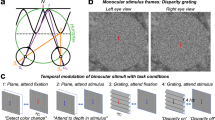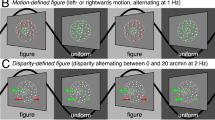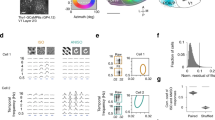Abstract
The horizontal separation of the eyes means that objects nearer or farther than the fixation point project to different locations on the two retinae, differing principally in their horizontal coordinates (horizontal binocular disparity). Disparity-selective neurons have generally been studied with disparities applied in only one direction1 (often horizontal), which cannot determine whether the encoding is specialized for processing disparities along the horizontal axis. It is therefore unclear if disparity selectivity represents a specialization for naturally occurring disparities. I used random dot stereograms to study disparity-selective neurons from the primary visual cortex (V1) of awake fixating monkeys. Many combinations of vertical and horizontal disparity were used, characterizing the surface of responses as a function of two-dimensional disparity. Here I report that the response surface usually showed elongation along the horizontal disparity axis, despite the isotropic stimulus. Thus these neurons modulated their firing rate over a wider range of horizontal disparity than vertical disparity. This demonstrates that disparity-selective cells are specialized for processing horizontal disparity, and that existing models2,3 of disparity selectivity require substantial revision.
This is a preview of subscription content, access via your institution
Access options
Subscribe to this journal
Receive 51 print issues and online access
$199.00 per year
only $3.90 per issue
Buy this article
- Purchase on Springer Link
- Instant access to full article PDF
Prices may be subject to local taxes which are calculated during checkout





Similar content being viewed by others
References
Cumming, B. G. & DeAngelis, G. C. The physiology of stereopsis. Annu. Rev. Neurosci. 24, 203–238 (2001)
Ohzawa, I. Mechanisms of stereoscopic vision: the disparity energy model. Curr. Opin. Biol. 8, 509–515 (1998)
Ohzawa, I., DeAngelis, G. C. & Freeman, R. D. Stereoscopic depth discrimination in the visual cortex: Neurons ideally suited as disparity detectors. Science 249, 1037–1041 (1990)
Mayhew, J. & Longuet-Higgins, H. C. A computational model of binocular depth perception. Nature 297, 376–378 (1982)
Howard, I. P. & Rogers, B. J. Binocular Vision and Stereopsis (Oxford Univ. Press, Oxford, 1995)
Anzai, A., Ohzawa, I. & Freeman, R. D. Neural mechanisms for processing binocular information II. Complex cells. J. Neurophysiol. 82, 909–924 (1999)
Barlow, H. B., Blakemore, C. & Pettigrew, J. D. The neural mechanisms of binocular depth discrimination. J. Physiol. (Lond.) 193, 327–342 (1967)
Joshua, D. E. & Bishop, P. O. Binocular single vision and depth discrimination: Receptive field disparities for central and peripheral vision and binocular interaction of peripheral single units in cat striate cortex. Exp. Brain Res. 10, 389–416 (1970)
Heydt, R. v. d., Adorjani, C., Anny, P. H. & Baumgartner, G. Disparity sensitivity and receptive field incongruity of units in the cat striate cortex. Exp. Brain Res. 31, 523–545 (1978)
Maunsell, J. H. R. & van Essen, D. C. Functional properties of neurons in middle temporal visual area of the macaque monkey. II. Binocular interactions and sensitivity to binocular disparity. J. Neurophysiol. 49, 1148–1166 (1983)
Nieder, A. & Wagner, H. Encoding of both vertical and horizontal disparity in random-dot stereograms by Wulst neurons of awake barn owls. Vis. Neurosci. 18, 541–547 (2001)
DeAngelis, G. C., Ohzawa, I. & Freeman, R. D. Depth is encoded in the visual cortex by a specialized receptive field structure. Nature 352, 156–159 (1991)
Hubel, D. H. & Wiesel, T. N. Receptive fields and functional architecture of monkey striate cortex. J. Physiol. (Lond.) 195, 215–243 (1968)
Cumming, B. G. & Parker, A. J. Responses of primary visual cortical neurons to binocular disparity without depth perception. Nature 389, 280–283 (1997)
Ohzawa, I., DeAngelis, G. C. & Freeman, R. D. Encoding of binocular disparity by complex cells in the cat's visual cortex. J. Neurophysiol. 77, 2879–2909 (1997)
Livingstone, M. S. & Tsao, D. Y. Receptive fields of disparity-selective neurons in macaque striate cortex. Nature Neurosci. 2, 825–832 (1999)
Cumming, B. G. & Parker, A. J. Binocular neurons in V1 of awake monkeys are selective for absolute, not relative, disparity. J. Neurosci. 19, 5602–5618 (1999)
Cumming, B. G. & Parker, A. J. Local disparity not perceived depth is signalled by binocular neurons in cortical area V1 of the macaque. J. Neurosci. 20, 4758–4767 (2000)
Prince, S. J. D., Pointon, A. D., Cumming, B. G. & Parker, A. J. The precision of single neuron responses in cortical area V1 during stereoscopic depth judgements. J. Neurosci. 20, 3387–3400 (2000)
Prince, S. J. D., Cumming, B. G. & Parker, A. J. Range and mechanism of horizontal disparity encoding in macaque V1. J. Neurophysiol. 87, 209–221 (2002)
Author information
Authors and Affiliations
Corresponding author
Ethics declarations
Competing interests
The authors declare that they have no competing financial interests.
Rights and permissions
About this article
Cite this article
Cumming, B. An unexpected specialization for horizontal disparity in primate primary visual cortex. Nature 418, 633–636 (2002). https://doi.org/10.1038/nature00909
Received:
Accepted:
Issue Date:
DOI: https://doi.org/10.1038/nature00909
This article is cited by
-
Cross-subject aesthetic preference recognition of Chinese dance posture using EEG
Cognitive Neurodynamics (2023)
-
Human group coordination in a sensorimotor task with neuron-like decision-making
Scientific Reports (2020)
-
Revisiting the functional significance of binocular cues for perceiving motion-in-depth
Nature Communications (2018)
-
Stereo vision and strabismus
Eye (2015)
-
Differential human brain activation by vertical and horizontal global visual textures
Experimental Brain Research (2010)
Comments
By submitting a comment you agree to abide by our Terms and Community Guidelines. If you find something abusive or that does not comply with our terms or guidelines please flag it as inappropriate.



